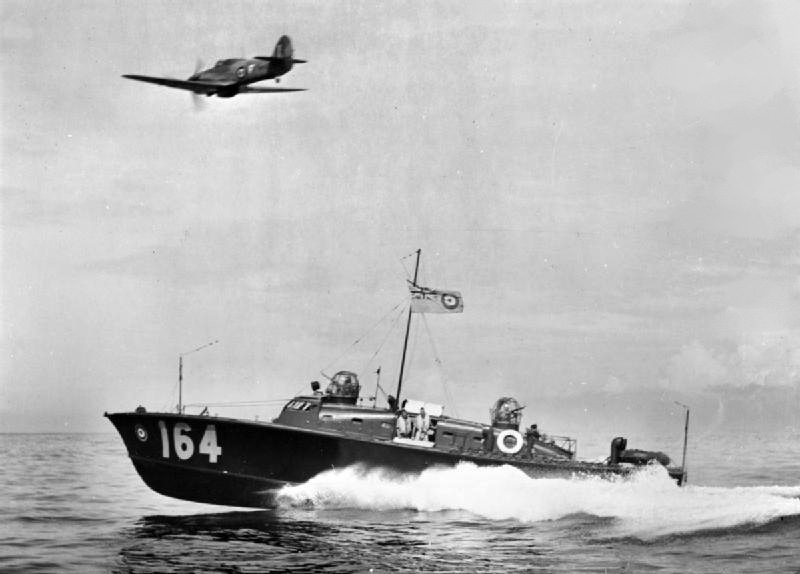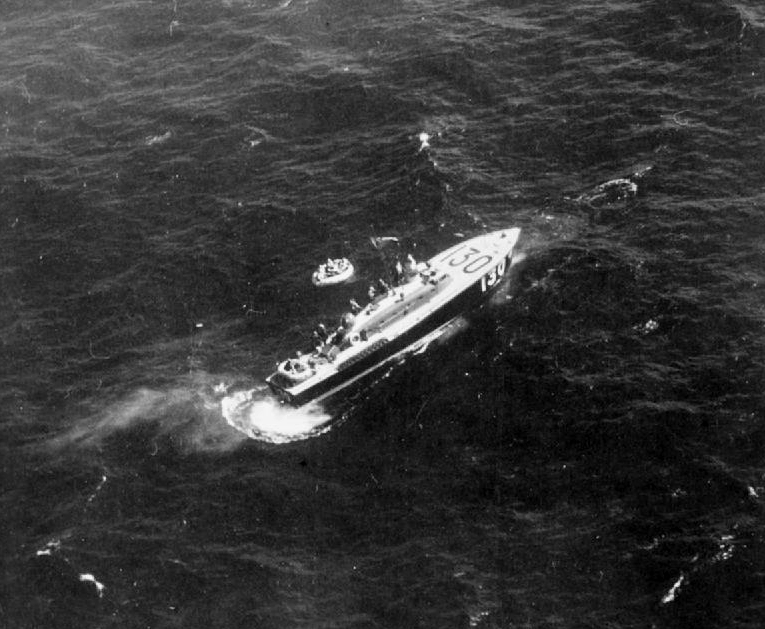|
Motor Launch
A Motor Launch (ML) is a small military vessel in Royal Navy service. It was designed for harbour defence and submarine chasing or for armed high-speed air-sea rescue. Some vessels for water police service are also known as motor launches. World War I service Although small by naval standards, it was larger than the preceding steam or diesel-engined harbour launches of 56ft and coastal motor boats of 40 and 55 ft length. The first motor launches entered service in the First World War. These were five hundred and eighty vessels built by the US Elco company for the Admiralty, receiving the numbers ML-1 to ML-580. They served with the Royal Navy between 1916 and the end of the war, defending the British coast from German submarines. Some of the earliest examples, including ML 1, also served in the Persian Gulf from June 1916. After the Armistice of 11 November 1918 a flotilla of 12 Royal Navy motor launches travelled down the Rhine performing duty as the Rhine Patrol ... [...More Info...] [...Related Items...] OR: [Wikipedia] [Google] [Baidu] |
Electric Launch Company
The Electric Launch Company, later renamed Elco Motor Yachts ("Elco"), is an American boat building and electric motor company that has operated from 1893 to 1949 and from 1987 to the present. History Elco first made its mark at the World's Columbian Exposition of 1893 in Chicago. Fifty-five launches, each 36 feet long and powered by battery-driveelectric motors carried over a million passengers. In 1899 Isaac Rice, president of the Electric Storage Battery Company and owner of Electric Boat Company, now Electro-Dynamic Company, (both suppliers to Elco), acquired Elco as a subsidiary of his new Electric Boat Company. Elco built a new boatyard in Bayonne, New Jersey soon afterward. Previously, Elco boats had been built in subcontracted facilities. By 1900, electric-powered pleasure boats outnumbered the combined number of boats powered by steam and explosive engines (as gasoline-powered motors were called). By 1910, the advantages of the range and power of gasoline came to domi ... [...More Info...] [...Related Items...] OR: [Wikipedia] [Google] [Baidu] |
Motor Launch ML-286
Motor Launch ML-286 is a First World War submarine chaser built by Elco, that saw action with Royal Navy. It is also listed as one of the Little Ships that were used in the 1940, Dunkirk evacuation. It is currently in a very poor condition and lies on the banks of the River Thames at Isleworth Ait. ML-286 is the last surviving Royal Naval 'Motor Launch' of the more than 550 that served in the First World War. World War I service The first motor launches entered service in the First World War. These were 580 vessels built by the US Elco company for the Admiralty, receiving the designations ML-1 to ML-580. They served between 1916 and the end of the war with the Royal Navy defending the British coast from German submarines. Her first commander was the War artist, Lieutenant Geoffrey Allfree (1889–1918) Dunkirk and post-war conversion to a house boat After the War ML286 was sold off by the Ministry and was given the name ''Cordon Rouge'' and then later, in 1930 she becam ... [...More Info...] [...Related Items...] OR: [Wikipedia] [Google] [Baidu] |
Motor Gunboat
The motor gun boat (MGB) was a small, high-speed British military vessel of the Second World War, which was armed with a mix of guns, in contrast to the physically similar motor torpedo boat (MTB), whose main offensive weapon were torpedoes. The small size of the MGBs, and their high speed, made them difficult targets for German E-boats, though, like their opponents, they were limited by heavy weather, because they did not provide a stable-enough platform to aim the guns. The large number of guns meant the crew was relatively large, numbering as high as thirty men on the largest boats. Description MGBs were extremely heavily armed for vessels of their size. Early MGBs were, nevertheless, small boats, being based on Motor Anti-Submarine Boats of 63-70 feet in length; these would later be considered 'short' boats by Coastal Forces. These were mostly equipped with one heavy weapon and numerous lighter guns. The later 71.5-feet short MGBs would sport two heavy weapon locations ... [...More Info...] [...Related Items...] OR: [Wikipedia] [Google] [Baidu] |
High-speed Launch
A high-speed launch (HSL) is a type of military boat typically used for air-sea rescue operations. The British Royal Air Force (RAF) and others used HSLs especially during World War II. The 64 ft. high-speed, air/sea rescue launch built by British Power Boat Company (BPBC) was one of the earliest high-speed offshore rescue vessel used by the Royal Air Force. The prototype, numbered 100, gave its name to the class as the "100 class"; High Speed Launch 102 is the only surviving boat from that class. It was tested in 1936 and production boats were delivered in 1937. Later designs included the 1941 Type Two 63 ft HSL The Type Two HSL was a 63 ft high-speed launch craft made by British Power Boat Company (BPBC). The craft were used during the Second World War for air-sea rescue operations to save Allied aircrew from the sea. The Type Two superseded the 64 ... "Whaleback", an adaptation of a motor anti-submarine boat, the first HSL to include gun turrets. British Power Bo ... [...More Info...] [...Related Items...] OR: [Wikipedia] [Google] [Baidu] |
Harbour Launch
The harbour launch was a type of small launch used by the Royal Navy for general duties around Royal Naval dockyards and sea ports. The first were built in the 1850s with the advent of the steam engine and were originally designated harbour service launches. From the 1890s to the 1960s they were built to the same common design, first with steam engines and later with diesel engines, by small yards contracted locally by dockyards and bases. In 1942, following the introduction of the Type Two 63 ft HSL by the Royal Air Force, Admiralty Fleet Order 1518 re-designated the harbour service launch as "Harbour Launch (Steam)" or "Harbour Launch (Diesel)", depending on the type of engine. |
National Historic Ships
National Historic Ships UK is a government-funded independent organisation that advises UK governments and others on matters relating to historic ships.https://www.nationalhistoricships.org.uk/about, About us , National Historic Ships UK website. Accessed 18 January 2022. It is sponsored by the , the and the |
English Channel
The English Channel, "The Sleeve"; nrf, la Maunche, "The Sleeve" (Cotentinais) or ( Jèrriais), (Guernésiais), "The Channel"; br, Mor Breizh, "Sea of Brittany"; cy, Môr Udd, "Lord's Sea"; kw, Mor Bretannek, "British Sea"; nl, Het Kanaal, "The Channel"; german: Ärmelkanal, "Sleeve Channel" ( French: ''la Manche;'' also called the British Channel or simply the Channel) is an arm of the Atlantic Ocean that separates Southern England from northern France. It links to the southern part of the North Sea by the Strait of Dover at its northeastern end. It is the busiest shipping area in the world. It is about long and varies in width from at its widest to at its narrowest in the Strait of Dover."English Channel". ''The Columbia Encyclopedia'', 2004. It is the smallest of the shallow seas around the continental shelf of Europe, covering an area of some . The Channel was a key factor in Britain becoming a naval superpower and has been utilised by Britain as a natural ... [...More Info...] [...Related Items...] OR: [Wikipedia] [Google] [Baidu] |
British Power Boat Company Type Two 63 Ft HSL
The Type Two HSL was a 63 ft high-speed launch craft made by British Power Boat Company (BPBC). The craft were used during the Second World War for air-sea rescue operations to save Allied aircrew from the sea. The Type Two superseded the 64 ft HSL, and was itself replaced by the Type Three 68 ft "Hants and Dorset" also built by the BPBC. The Type Two (aka Type 2) was nicknamed the "Whaleback" due to the distinctive curve to its deck and humped cabin. History The Type Two was designed in 1937 by George Selman, Chief Designer and Naval Architect of the British Power Boat Company, which was founded by Hubert Scott-Paine at Hythe. Scott-Paine had previously owned the Supermarine Aviation Company, later builders of the Supermarine Spitfire and several flying boat types. A low-set cabin contained the wheel-house, chart room and a sickbay. For defence against enemy aircraft, on top of the cabin were two aircraft-style turrets made by Armstrong-Whitworth initially with a sing ... [...More Info...] [...Related Items...] OR: [Wikipedia] [Google] [Baidu] |
Anti-submarine
An anti-submarine weapon (ASW) is any one of a number of devices that are intended to act against a submarine and its crew, to destroy (sink) the vessel or reduce its capability as a weapon of war. In its simplest sense, an anti-submarine weapon is usually a projectile, missile or bomb that is optimized to destroy submarines. History Before World War I Prior to about 1890, naval weapons were only used against surface shipping. With the rise of the military submarine after this time, countermeasures were considered for use against them. The first submarine installation of torpedo tubes was in 1885 and the first ship was sunk by a submarine-launched torpedo in 1887. There were only two ways of countering the military submarine initially: ramming them or sinking them with gunfire. However, once they were submerged, they were largely immune until they had to surface again. By the start of the First World War there were nearly 300 submarines in service with another 80 in production ... [...More Info...] [...Related Items...] OR: [Wikipedia] [Google] [Baidu] |
Fairmile B Motor Launch
The Fairmile Type-B motor launch was a type of motor launch (often referred to as MLs) built by British boatbuilder Fairmile Marine and others during the Second World War for the Royal Navy for coastal operations. Design While the Type A had been designed entirely by Fairmile, the Type B design had come from Bill Holt of the Admiralty based on the lines of a destroyer hull and the detailed design and production was taken on by Fairmile. Like all their designs it was based on total prefabrication so individual components could be contracted out to small factories for production and these arranged as kits that would be delivered to various boatyards for assembly and fitting out. Altogether approximately 650 boats were built between 1940 and 1945. Like the A Type, the B Type were initially intended as submarine chasers, so the boats were fitted with ASDIC (sonar) as standard. Their main armament initially reflected their anti-submarine focus, with 12 depth charges, a single QF ... [...More Info...] [...Related Items...] OR: [Wikipedia] [Google] [Baidu] |
Minelayer
A minelayer is any warship, submarine or military aircraft deploying explosive mines. Since World War I the term "minelayer" refers specifically to a naval ship used for deploying naval mines. "Mine planting" was the term for installing controlled mines at predetermined positions in connection with coastal fortifications or harbor approaches that would be detonated by shore control when a ship was fixed as being within the mine's effective range. Before World War I, mine ships were termed mine planters generally. For example, in an address to the United States Navy ships of Mine Squadron One at Portland, England, Admiral Sims used the term “mine layer” while the introduction speaks of the men assembled from the “mine planters”. During and after that war the term "mine planter" became particularly associated with defensive coastal fortifications. The term "minelayer" was applied to vessels deploying both defensive- and offensive mine barrages and large scale sea mining ... [...More Info...] [...Related Items...] OR: [Wikipedia] [Google] [Baidu] |






